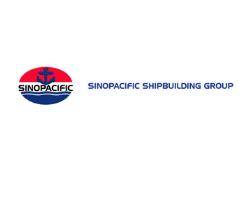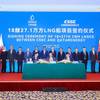Sinopacific Shipbuilding Group’s “Upwind Sailing Strategy”
“Shipbuilding enterprises must be able to handle any strong waves that come their way, and their ships must be solidly built yet be able to move flexibly. This is reflected in not only the ships that we produce, but it is also reflected in our abilities as an enterprise to handle the challenges of the market.” Sinopacific Shipbuilding Group Chairman Simon Liang summarizes his own “upwind sailing strategy.”
Since 2008, the Chinese shipbuilding industry has experienced many ups and downs. The first was the big increase in shipbuilding steel material prices in 2008, with the prices at some steel producers reaching 10,000 RMB per ton, resulting in price increases of 21% to 30% over four months. The next challenge was the slump of the international shipping market in 2009 as impacted by the global financial crisis, which caused many shipbuilding enterprises to see a sharp decrease in orders. Then in 2010, the Chinese shipbuilding industry, which had just started to get back on track, suffered another setback: steel and iron companies continuously raised their prices for ship plates. The average price for ship plates jumped by 87% at the most. Until the beginning of this year, Angang Steel and Baosteel have continually adjusted their ship plate prices upward, and it can be expected that the prices will continue to rise in the future. In addition, other raw material prices and labor prices also increased. Therefore, cost control became the key for the fortunes and the very survival of shipbuilding enterprises. As the leading privately-run shipbuilding enterprise in China, Sinopacific Shipbuilding Group decided to follow the philosophy of winning through excellence and growing through teamwork.
What is meant by the word excellence? The key is to always strive to improve in one’s strongest areas, without sparing any efforts. The strongest area of Sinopacific Shipbuilding Group is its differentiated product strategy to “Perfection in simple products” ”Leadership in niche market”. Its two shipyards have respectively become one of the world’s most efficient shipbuilder of commercial ships and a top global offshore support vessels builder, and they each have a relatively mature line of products. By relying on these products, Sinopacific Shipbuilding Group was able to strip off auxiliary manufacturing businesses that are not part of its core competitiveness and has concentrated its advantages of human, financial, and material resources into the higher value links such as R&D and design, one body management, and brand building. It has optimized design indicators according to the product requirements to form standards for the local market and the industry. Sinopacific Shipbuilding Group has gradually realized a transformation from selling products singly to selling standards and products simultaneously, thus leading along market development. For example, the group has promoted the implementation of a comprehensive integrated mode of logistics, processing, and distribution for steel materials, stripping off all the low value-added processes and links such as ship plate pre-treatment, initial processing, sub-fabricating, and mid-fabricating. The steel suppliers now implement mass production and do processing and distribution so that the shipyards can focus on setting technical standards, providing an optimized order structure, and doing informatized construction,
What is meant by the word teamwork? With the many uncertain factors in the market, privately-run enterprises need to cooperate with many partners to be able to form the “bulk effect” that state-owned enterprises naturally possess and to navigate the stormy markets with stability. Therefore, to focus its efforts on doing what it does best, Sinopacific Shipbuilding Group has established the Sinopacific Shipbuilding Affiliated Industrial Base to cultivate an auxiliary equipment industry cluster beneficial to specialized, intensive, and mass production to bring about scale production of auxiliary products.
“By stripping off manufacturing businesses that are not part of the core competitiveness of the shipyard and by establishing strategic alliances with suppliers to actively look for strategic cooperative partner and establish the Sinopacific local alliance in the two areas of non-strategic materials and strategic materials, this allows us to be able to concentrate our efforts on creating higher added value and also work with our upstream and downstream suppliers to increase integrated competitiveness. This is the ‘upwind strategy’ of the Sinopacific Shipbuilding Group,” announced the Group’s Chairman Simon Liang.
In order to achieve smooth collaboration with its supplier alliances, Sinopacific has set four basic principles for the selection of its cooperative partners. First, their experience and quality must meet the criteria stated by Sinopacific. Second, they must accept Sinopacific’s culture, management style, and business model of innovation and process re-engineering. Third, they must have open minds, understand and accept Sinopacific's leading technologies, market guidance, and identification of strategies. Fourth, they must possess innovation and the ability to learn quickly, pick up and follow the guidance of Sinopacific and create novel cooperative models within real situations.
Although the requirements seem strict, only by establishing cooperative relations in this way can such relations be solid enough, reliable enough, and fully bring about stronger cooperative strength for a true win-win situation. Sinopacific Shipbuilding Group’s supplier stated that through cooperation with Sinopacific they had both reduced the stocking levels of raw materials and parts and also accelerated cash conversion. In this process, they have also shared experiences to greatly raise their respective overall levels of enterprise management.
Supply chain competition has become one of the crucial links for shipyards in the 21st century. In this light, Sinopacific Shipbuilding Group’s “captain” - Chairman Simon Liang – stated with clear awareness: “We well-recognize our status and competitive advantage in the value chain, and we are not passively ‘standing pat’ or just worrying about ourselves in the value chain. Instead, we are bringing into full play our overall capabilities as a shipbuilding enterprise within the value chain. Using our strategic alliances with suppliers, we have effectively connected the upstream and downstream to revitalize and enhance the competitiveness of the whole value chain. While providing a win-win situation, Sinopacific Shipbuilding Group also lowers costs and raises enterprise operating efficiency. We have confidence that we can transform the pressures and challenges of costs into opportunities for expansion and growth.”
Source: Sinopacific Shipbuilding












